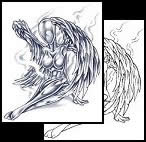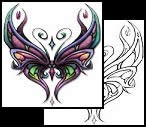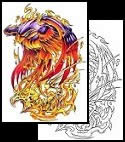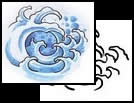|
TOP 10
TATTOO DESIGNS & SYMBOLS In the interests of research and as an ongoing barometer of popular
culture we present you with an update of the
Top Ten Tattoo Designs Search.
You can access the archived top 10 lists on
this page.
The Top 10 Tattoo Designs and Symbols, based on our site searches ending
11/31/06.
The Top Ten Tattoo Designs for the month of November are a near
perfect list of reoccurring tattoo classics - dragons, the phoenix,
butterflies and stars, mixed with the most popular tattoo designs of
the past few years, tribal tattoo designs, angels and crosses. A
third of the tribal tattoo design searches focused on Maori and
other Polynesian design styles. The interest in dragons and the
phoenix shows the continuing influence that Japanese tattooing has
had since the days of Sailor Jerry Collins in Hawaii in the forties
and fifties, and Don Ed Hardy in San Francisco since the sixties and
seventies. Tattoo designs like stars and crowns can be traced back
well over a century, a testimony to their enduring power as potent
symbols for aficionados of body art.
 1.
Tribal Tattoos -
The fascination with tribal tattoo designs just keeps chugging
along, and the beautiful curvilinear Maori designs continues to
attract those looking for distinctive body art. 1.
Tribal Tattoos -
The fascination with tribal tattoo designs just keeps chugging
along, and the beautiful curvilinear Maori designs continues to
attract those looking for distinctive body art.
Tribal Tattoos account for nearly a third of all tattoo design
search requests, and the term "tribal" of course covers an
astonishing array of tattoo design possibilities, from the
traditional tribal tattoos of indigenous and aboriginal cultures, to
the latest in graphic design for the body.
Maori tattooing is a
distinct school of patterns and graphic designs within Polynesian
tattooing. While much of Polynesian tattooing is derived from
straight-line geometric patterns (and thought to originate with
patterns found on ancient Lapita pottery shards such as have been
discovered in Samoa), a design fact which rose in part because the
traditional Polynesian tattoo combs are best suited to linear
designs, Maori tattooing is essentially curvilinear, and the
mainstay of Maori designs are based on the spiral. It should be
noted that renowned traditional Hawaiian artist
Keone Nunes has demonstrated that it is possible to reproduce
complex curved designs using traditional Polynesian tattooing
implements.
 2.
Star / Stars -
Stars are often encountered as symbols, and many cases the meaning
of a particular star symbol may depend upon the number points it
has, and sometimes the orientation of these points as well. As a
light shining in the darkness, the star is often considered a symbol
of truth, of the spirit and of hope. The symbol of the star embodies
the concept of the divine spark within each of us. Their nocturnal
nature leads stars to represent the struggle against the forces of
darkness and the unknown 2.
Star / Stars -
Stars are often encountered as symbols, and many cases the meaning
of a particular star symbol may depend upon the number points it
has, and sometimes the orientation of these points as well. As a
light shining in the darkness, the star is often considered a symbol
of truth, of the spirit and of hope. The symbol of the star embodies
the concept of the divine spark within each of us. Their nocturnal
nature leads stars to represent the struggle against the forces of
darkness and the unknown Stars with a specific design have taken on an explicit
meaning and symbolism on their own. Among the most well-know of
these are the Pentagram (five-pointed star), the Nautical Star
(five-pointed star), the Hexagram or Star of David (six-pointed
star), all the way to the nonagram (nine-pointed star).
 3.
Angel/Angels
- An angel tattoo design is an overtly religious symbol. Angels are
anthropomorphic - meaning in the shape of men - winged forms
intended to transmit the word of God to humankind. Angels personify
divine will and are the messengers of God. Winged messengers appear
in a number of religions as intermediaries between the spiritual and
material worlds, but appear most often in Islamic, Jewish but most
particularly the Christian faiths. The word angel comes from the
Greek 'aggelos', meaning messenger. Angels make frequent appearances
in the Christian Bible, not only as messengers of God but also
delivering his protection or punishment. Angels act as God's
intermediaries, carrying out God's will in the affairs of man. 3.
Angel/Angels
- An angel tattoo design is an overtly religious symbol. Angels are
anthropomorphic - meaning in the shape of men - winged forms
intended to transmit the word of God to humankind. Angels personify
divine will and are the messengers of God. Winged messengers appear
in a number of religions as intermediaries between the spiritual and
material worlds, but appear most often in Islamic, Jewish but most
particularly the Christian faiths. The word angel comes from the
Greek 'aggelos', meaning messenger. Angels make frequent appearances
in the Christian Bible, not only as messengers of God but also
delivering his protection or punishment. Angels act as God's
intermediaries, carrying out God's will in the affairs of man.
Symbols closely associated with angels in art include trumpets,
harps, swords, sceptres and wands. Angels are usually portrayed as
young men with wings and halos, representing their divinity. The
representation of angels as Cupid-like young boys or babies, 'putti'
did not occur until the period of the Renaissance.
As a tattoo design, an angel is a symbol of devotion, spirituality
and faith and signifies a relationship with God. An angel can be
intended as a figure of guidance and protection. An angel is often
used as the centerpiece of a tattoo that is intended as a memorial.
 4.
Dragon - a dragon
is a classic tattoo design that shows the influence of Japanese and
Chinese culture in western tattooing. This design is popular with
both men and women. A dragon is wondrous monster, often thought of
as a giant winged, fire breathing lizard or snake. The word is
derived from the French and Latin form of the Greek, drakwu,
connected with derkomai "see," and interpreted as "sharp-sighted."
The equivalent English word "drake" or "fire-drake" is derived from
Anglo-Saxon draca. 4.
Dragon - a dragon
is a classic tattoo design that shows the influence of Japanese and
Chinese culture in western tattooing. This design is popular with
both men and women. A dragon is wondrous monster, often thought of
as a giant winged, fire breathing lizard or snake. The word is
derived from the French and Latin form of the Greek, drakwu,
connected with derkomai "see," and interpreted as "sharp-sighted."
The equivalent English word "drake" or "fire-drake" is derived from
Anglo-Saxon draca.
 5.
Wings - Wings as a tattoo design can often have
inspirational or spiritual symbolism. In many myths, wings often
have to be earned by their wearer. Wings, often associated with
birds, represent speed, elevation, freedom and aspiration. 5.
Wings - Wings as a tattoo design can often have
inspirational or spiritual symbolism. In many myths, wings often
have to be earned by their wearer. Wings, often associated with
birds, represent speed, elevation, freedom and aspiration.
Wings associated with angels are spiritual, symbolizing
enlightenment, guidance and protection - to be taken under the wing
- and inspirational.
Wings associated with butterflies, dragonflies, fairies,
mythological winged creatures like dragons, griffins, and the
winged-horse Pegasus, have an element of the magical about them. As
in alchemy and magic, wings can be transformational, allowing an
individual access to a previously unattainable state. The presence
of wings allows the combination of different elements, earth and
sky, wind and fire.
 6.
Cross/crosses
- religious symbolism is very popular and prominently featured in
several tattoo design genres. One of the most ancient, widespread,
and important symbols, the vertical and horizontal lines
representing Father and Mother Nature respectively. Some of its
forms are the ank or tau, swastika or Thor's Hammer, crux ansata or
cross with a handle, denoting power over material nature. The four
arms of the cross represent the four elements, and its central point
their synthesis or laya-point. 6.
Cross/crosses
- religious symbolism is very popular and prominently featured in
several tattoo design genres. One of the most ancient, widespread,
and important symbols, the vertical and horizontal lines
representing Father and Mother Nature respectively. Some of its
forms are the ank or tau, swastika or Thor's Hammer, crux ansata or
cross with a handle, denoting power over material nature. The four
arms of the cross represent the four elements, and its central point
their synthesis or laya-point.
 7.
Butterfly Tattoo
Designs - Its ranking shows the influence that women have in
tattoo culture, as butterfly designs are an overwhelmingly feminine
tattoo choice. The butterfly, because of its short life, its
physical beauty, and its fluttering from flower to flower seeking
nectar, has among many ancient peoples been regarded as an emblem of
the impermanent, unstable characteristics of the lower human soul.
The caterpillar lives its period, making for itself a chrysalis,
which after a stage of dormancy is broken by the emerging butterfly.
This suggests the idea of the less becoming the greater, of an
earthy entity becoming aerial. These thoughts led the ancient Greeks
to use the butterfly as a symbol of the human soul (psyche); and in
their mythology Psyche was in consequence represented in art with
butterfly wings. 7.
Butterfly Tattoo
Designs - Its ranking shows the influence that women have in
tattoo culture, as butterfly designs are an overwhelmingly feminine
tattoo choice. The butterfly, because of its short life, its
physical beauty, and its fluttering from flower to flower seeking
nectar, has among many ancient peoples been regarded as an emblem of
the impermanent, unstable characteristics of the lower human soul.
The caterpillar lives its period, making for itself a chrysalis,
which after a stage of dormancy is broken by the emerging butterfly.
This suggests the idea of the less becoming the greater, of an
earthy entity becoming aerial. These thoughts led the ancient Greeks
to use the butterfly as a symbol of the human soul (psyche); and in
their mythology Psyche was in consequence represented in art with
butterfly wings.
 8.
Phoenix Tattoos - the
legendary mythological bird of fire, is probably the most popular of
all the rebirth and resurrection symbols. There are stories and
fables that touch on the Phoenix myth in the ancient Middle East,
India, China and the Greek and Roman Empires. 8.
Phoenix Tattoos - the
legendary mythological bird of fire, is probably the most popular of
all the rebirth and resurrection symbols. There are stories and
fables that touch on the Phoenix myth in the ancient Middle East,
India, China and the Greek and Roman Empires.
In the myth the Phoenix is an extraordinarily long-lived bird of
great beauty and luxuriant plumage (often described as golden or
red-hued), living five hundred years or more, a fact attributed by
one early Jewish legend that the Phoenix refused to eat the
forbidden fruit of Paradise. At the end of it's life the Phoenix
would build a nest of aromatic twigs, set fire to itself, and be
consumed in the funeral pyre of it's own making. After three days
the Phoenix would arise from the ashes, reborn.
The Phoenix was originally a symbol of the cycle of the rising and
setting of the sun but over time evolved to become a symbol of human
resurrection. On Roman coins the phoenix represented an undying
Empire. In the early Christian Church the phoenix was a symbol of
Christ's resurrection and everlasting life. The phoenix represented
the victory of life over death.
As a tattoo symbol, the Phoenix can be found in many tattoo genres,
but of the Far East in particular. It is a symbol of resurrection,
rebirth and regeneration. It also represents purification and
transformation through fire and adversity.
 9.
Japanese Tattoo Designs
- The art of Japanese tattoo has been traced back as far as 5,000
B.C. It is very possible that it existed well before this date, but
this is as far back as claims can be backed up with physical proof.
Clay figurines that date back to the 5th millennia B.C. have been
found with their faces painted or engraved to represent tattoo
markings. As far as historians and archaeologists can tell, these
tattoos are believed to have held a special religious or magical
meaning to their bearers. 9.
Japanese Tattoo Designs
- The art of Japanese tattoo has been traced back as far as 5,000
B.C. It is very possible that it existed well before this date, but
this is as far back as claims can be backed up with physical proof.
Clay figurines that date back to the 5th millennia B.C. have been
found with their faces painted or engraved to represent tattoo
markings. As far as historians and archaeologists can tell, these
tattoos are believed to have held a special religious or magical
meaning to their bearers.
Kanji is the calligraphy style letter writing method used by the
Japanese. It's a wildly popular choice among those seeking Japanese
style tattoo designs. By using Kanji, you can easily create and
display nearly any message you want. Some popular Kanji characters
translate into words like: Happiness, Wealth, Love, Lovers,
Laughter, Sadness, Beautiful, Duty and Loyalty.
Small flowers, or large intricate samurai warriors, Japanese style
tattoos work for anyone, almost anywhere. A koi lazily swimming
across a hip, an emerald serpent slithering up a calf, a ring of
cherry blossoms joined together in an ankle- or armband or a lady
and samurai embracing on your back, as wonderful as the art of
horimono is, you may find yourself enticed into wearing them all as
part of your personal tattoo gallery!
 10.
Crown Tattoos -
The crown has long been used as a symbol of royal power and
authority. Like the sceptre, the crown is a visible badge of office,
granting the wearer, it's possessor, the absolute right to rule.
That authority to rule was often held to be divinely inspired. In
the Christian tradition the garland of thorns placed on Christ's
head during the ordeal of his crucifixion is know as the "Crown of
Thorns". The centerpiece of any coronation of a new monarch is
always the moment when the new King, Queen, or Emperor has the state
crown placed upon their head. At that moment the power to rule is
transferred to the new monarch. 10.
Crown Tattoos -
The crown has long been used as a symbol of royal power and
authority. Like the sceptre, the crown is a visible badge of office,
granting the wearer, it's possessor, the absolute right to rule.
That authority to rule was often held to be divinely inspired. In
the Christian tradition the garland of thorns placed on Christ's
head during the ordeal of his crucifixion is know as the "Crown of
Thorns". The centerpiece of any coronation of a new monarch is
always the moment when the new King, Queen, or Emperor has the state
crown placed upon their head. At that moment the power to rule is
transferred to the new monarch.
As a symbol, the crown also symbolizes leadership, and the rightful
authority which comes from being elected by a group to serve as
their leader.
Many groups have used the crown to symbolize the power and authority
to lead or command. When it is combined with a cross, one of the
meanings of the crown is "victory," and the cross symbolizes
Christianity. Many Royal crowns in Europe incorporated the Christian
Cross into their design, reinforcing the Monarch's claim that their
right to the throne was a divine right and that the Monarch was
guided by the hand of God.
As a tattoo symbol, the crown doesn't just mean the right of one
person to command another. It symbolizes and individual's
sovereignty over their own life, feelings, thoughts, and actions.
The crown symbolizes self-control, and is a reminder to use power
and authority wisely and justly.
For great tattoo design ideas, check out our good friends at
TattooJohnny.com
Alphabetical Listing of Tattoo Symbols & Designs
A
B
C
D
E
F
G
H
I
J
K
L
M
N
O
P
Q
R
S
T
U
V
W
X
Y
Z

|

 1.
1.









